Universal Studios, A Corporate Odyssey
103 YEARS OF UNIVERSAL STUDIOS: An Historical Overview
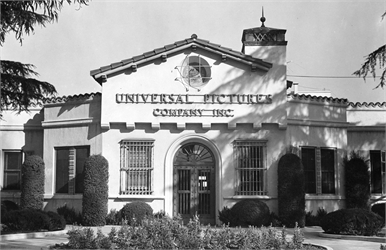
Today in 2015 Universal Studios is a part of a major international conglomerate known as NBCUniversal/Comcast owned by the internet giant Comcast. Its production studios are at 100 Universal City Plaza Drive in Universal City California. The company consists of subsidiaries Universal Studios Florida, Universal Animation, Focus Features, Gramercy Pictures, Illumination Entertainment, United International Pictures, Universal Parks & Resorts, Universal City Walk, Universal Studios Tour, Universal Hilton & Towers, Sheraton Universal Hotel, NBC Television among others.
Universal Film Manufacturing Company was founded by various independent film companies, IMP (Independent Motion Picture Company)- Laemmle, Champion, NYMPC (New York Motion Picture Company)-Bison, Powers, Centaur-Nestor Film Company, Yankee, Brulator, Éclair and Rex on April 30, 1912. By the summer of 1912 IMP Company founder Carl Laemmle became its president. Laemmle had been in the retail business before he purchased with a partner his first nickelodeon in Chicago Illinois in 1906. By 1908 the Edison backed Motion Picture Trust had taken control of all motion picture rentals, camera and film stock and licensed everything to all film companies interested in the motion picture business. Carl Laemmle formed the IMP (Independent Motion Picture Company) in 1909 and began to make his own films instead of renting them from Trust controlled sources. Laemmle and the other independents revolted against this industry control and a legal battle resulted that lasted for around ten years. By 1910 Laemmle created the ‘star-system’ by naming his leading players which helped his box-office. His first ‘star’ was Florence Lawrence who was formerly known as ‘The Biograph Girl’ along with actor King Baggot. By the end of 1912 all of the original partners in the creation of Universal either left the group or were absorbed into the greater Universal Film Mfg. Company. The new Universal Company included movie production, distribution and exhibition venues all linked in the same corporate entity, one of the first film companies to embrace the coming Studio system era.
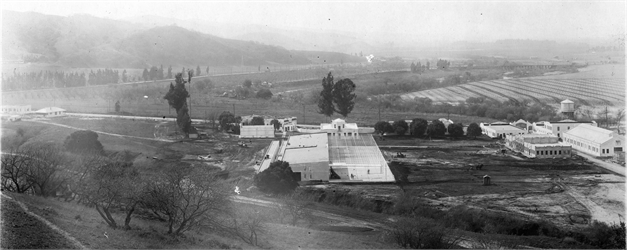
Universal 1915 View of Universal City Lankershim Blvd view west to Ventura Blvd – Photo by Park Ries
Following the westward trend of the industry, by the summer of 1912, Universal opened a Hollywood studio and leased a large ranch in the San Fernando Valley. In the summer of 1913 Laemmle and his Board of Directors made the decision to create “Universal City” a publicity face to the legal entity of North Hollywood with a goal to develop the ‘Ranch’ into a major production facility. At this time the owners of the ‘Ranch’ property refused to sell to Universal, so almost immediately the company purchased an adjoining ranch to the west at Lankershim Boulevard in 1914 and opened the “World’s largest motion picture production facility on the west coast on March 14, 1915. With the formal opening of Universal City came the inauguration of the first Universal Studio Tour. Permanent buildings were constructed along Lankershim Boulevard along with new stages and various production facilities. The early stars at this time included Francis Ford and Grace Cunard, Eddie Lyons, Lee Moran, Anna Little, J. Warren Kerrigan, Hobart Bosworth, Harry Carey Sr. and by the 1920s, Lon Chaney, Ford Sterling, Jack Hoxie, Hoot Gibson, Mary Philbin, John Boles, Norman Kerry, Laura La Plante, Reginald Denny, Erich Von Stroheim, Tom Mix and Baby Peggy. Character Lon Chaney became the most popular star of Universal during the 1920s with two of his biggest hits, The Hunchback of Notre Dame (1923),and The Phantom of the Opera (1925). It was during this period that Laemmle entrusted key production decisions to a young Irving Thalberg.
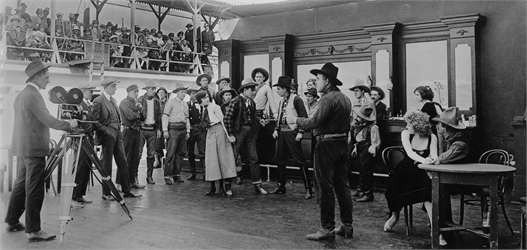
1916 back lot Universal Tour Harry Carey unit Love’s Lariat.
During the 1920s Universal owned the rights to the Oswald the Lucky Rabbit animated character which was later produced by Walter Lantz along with Woody Woodpecker. In 1928 Carl Laemmle appointed his son, Julius (Carl Laemmle Jr.) to head up the Universal Pictures production department. It was under Jr.’s leadership that the studio became equipped for sound film production and helped produce the famed Broadway show Showboat (1929) and Broadway (1929) which included Technicolor sequences and the first all-color musical feature film King Of Jazz (1930) and by 1930 the more serious All Quiet on the Western Front which won Best Picture Oscar. With the coming of the 1930s Laemmle Jr. created the ‘Horror’ genre for the studio which lasted for decades to come. Beginning with the production of Dracula (1931), Frankenstein (1931), The Mummy (1932), and The Invisible Man. Other Laemmle Jr. productions included Imitation of Life (1934) and My Man Godfrey (1936). Due to the Depression and the over-spending on the lavish productions released between 1929 and 1936 with Showboat as the last produced by Laemmle Jr., the studio took out a loan to finance the film (The Laemmle family’s controlling interest in Universal was put up as collateral). When the film went over budget, the banking company who put up the loan took control and foreclosed and seized the studio on April 2, 1936. Show Boat became a critical and financial success, but it was not enough for the Laemmle’s to stay with their company. The Laemmle’s were removed from the company they founded. During this time producer Joe Pasternak discovered singing sensation Deanna Durbin who starred in Three Smart Girls which was a box-office success. Deanna Durbin helped the “New Universal” continue as a major studio with money making releases and allowing the studio heads to find new talent. Universal borrowed or lured famous stars from other studios to star in Universal films. One of the more popular films of the 1930s was Destry Rides Again (1939) starring James Stewart and Marlene Dietrich.
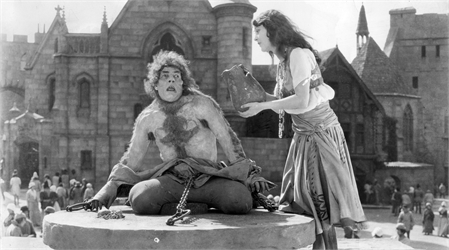
By the early 1940s the company was concentrating on lower-budget productions such as westerns, melodramas, comedies and serials along with sequels to the studio’s Horror film program. Stars lured to Universal by the 1940s included, W.C. Fields, James Stewart, Marlene Dietrich, Bing Crosby, Edgar Bergen, Abbott and Costello, Gloria Jean, Donald O’Connor, Peggy Ryan and famous directors such as Alfred Hitchcock who directed Saboteur (1942) and Shadow of a Doubt (1943). In 1945 British Producer and studio head J. Arthur Rank purchased an interest in Universal and later formed Universal-International Productions in 1946. William Goetz, a founder of International was made head of production. Universal-International released such classic films as Great Expectations (1946)directed by David Lean and Hamlet (1948) starring Laurence Olivier. Universal’s famous film noir films included The Killers (1946) and The Naked City (1948) and Abbott and Costello led the way with comedy hits such as Abbott and Costello Meet Frankenstein (1948).
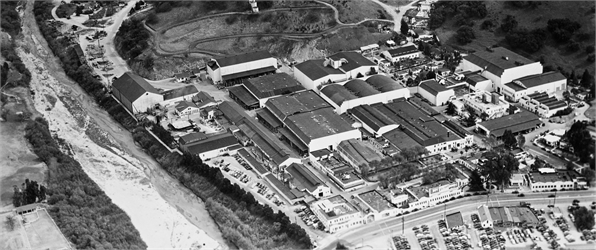
Universal 1947 Lankershim Blvd. @ bottom.
The 1950s brought a series of Arabian Nights films, many starring Tony Curtis and other hit films starring Rock Hudson, Jeff Chandler, Audie Murphy and John Gavin. By 1958 the Music Corporation of America (MCA), then a talent agency, had become television producers under its Revue Productions subsidiary. For $11 million MCA purchased the Universal Studios lot, not Universal Pictures. The studio lot was modernized and cleaned up while MCA clients such as Lana Turner, Cary Grant and Doris Day would make pictures for Universal along with an extended contract with director Alfred Hitchcock.
By 1962 Universal Pictures was taken over by MCA as part of a MCA-Decca Records merger. Two years later in 1964 MCA formed Universal City Studios, Inc., merging the motion pictures and television subsidiaries of Universal Pictures and Revue Productions into a modern studio and re-opening the Universal Studio Tour. Television made up most of the studio’s output in a deal with NBC. During this period Universal pioneered the ‘made-for-television’ movie. Paramount producer Hal B. Wallis moved over to Universal where he produced such films as Anne of a Thousand Days (1969) and Mary Queen of Scots (1971) and later Rooster Cogburn (1975) starring John Wayne.
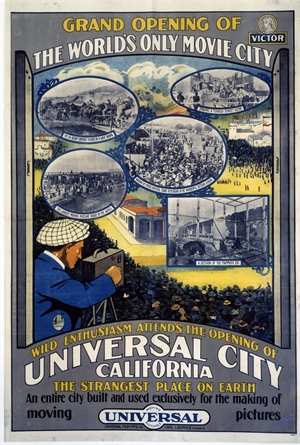 Universal teamed up with Paramount Pictures to form Cinema International Corporation in the 1970s to distribute both company’s films internationally. Universal continued to produce television shows and movies along with the occasional hit films as Airport (1970), The Sting (1973), American Graffiti (1973), Earthquake (1974 and , Jaws (1975). With the coming of the 1980s most of the backlot was demolished to make room for new sets and to accommodate the studio tours. Along with several back lot fires, the studio went under several major rebuilding projects. The 1980s brought several major hit films to the theatres, E.T. the Extra-Terrestrial (1982), Back to the Future (1985 and , Field of Dreams (1985).
Universal teamed up with Paramount Pictures to form Cinema International Corporation in the 1970s to distribute both company’s films internationally. Universal continued to produce television shows and movies along with the occasional hit films as Airport (1970), The Sting (1973), American Graffiti (1973), Earthquake (1974 and , Jaws (1975). With the coming of the 1980s most of the backlot was demolished to make room for new sets and to accommodate the studio tours. Along with several back lot fires, the studio went under several major rebuilding projects. The 1980s brought several major hit films to the theatres, E.T. the Extra-Terrestrial (1982), Back to the Future (1985 and , Field of Dreams (1985).
To expand the company into the broadcast and cable world, MCA president Lew Wasserman agreed to a deal with Japanese electronics manufacturer Matsushita Electric (now known as Panasonic) to acquire MCA for $6.6 billion in 1990. At this time Universal was renamed Universal Studios Inc. and continued to release notable box-office hits as Jurassic Park (1993). In 1995 Matsushita sold an 80% stake in MCA/Universal to the Canadian drinks company Seagram for $5.7 billion. The big release at this time was Apollo 13 (1995). Between 1996-1998 Universal released more box-office hits such as Twister (1996), The Lost World: Jurassic Park (1997) and , Liar Liar (1997). By 1999 Seagram purchased the entertainment company Polygram to round off its entertainment subsidiary holdings. Universal’s holdings were sold in June 2000 to Vivendi, which owned StudioCanal of France, a financial investment company. The new name of the company became Vivendi-Universal. At this time Universal released Dr. Seuss’ How the Grinch Stole Christmas (2000), Gladiator (2000). During the years of 2001 and 2003 Universal continued to release more major hit films as Jurassic Park III (2001), The Bourne Supremacy (2001), The Mummy Returns (2001) and A Beautiful Mind (2001) and Bruce Almighty (2003).
In 2004 Vivendi-Universal sold 80% of Vivendi Universal Entertainment including the studio and the theme parks to General Electric, parent of NBC Television. The resulting conglomerate was renamed NBCUniversal. At this time the studio releases that were box-office hits included Meet the Fockers (2004) that grossed $279,261,160. In 2005 Universal continued to make major box-office films and came out with King Kong (2005). The company continued to produce several of its franchise films and released The Bourne Ultimatum (2007). Despicable Me (2010) was released in 2010 and grossed over $251 million. By 2011 a 51% of the company was sold to cable provider Comcast. Then in January 29, 2011, Comcast merged the former GE subsidiary with its own cable television programming assets, creating the current NBCUniversal . During 2011 Universal released Fast & Furious 5 with a box-office take of over $209 million. In the following year the company took a chance on a comedy starring a ‘teddy bear’ naming the film as Ted (2012) and made over $218 million at the box-office. In March of 2013 Comcast purchased the remaining 49% of NBCUniversal for $16.7 billion. In 2013 Universal released Despicable Me 2 and Fast and Furious 6 with incredible box-office successes leading to Fast and Furious 7 in 2015 that grossed over $343 million. For 103 years Universal is the oldest motion picture studio still in operation in the Hollywood area and this year Universal Hollywood is celebrating its 100 year Anniversary on its present studio site.